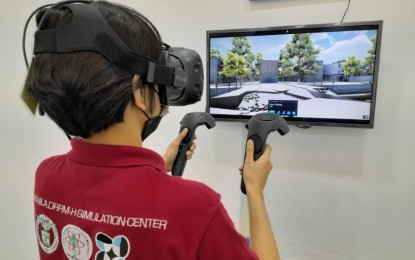
VIRTUAL SIMULATION. A staff of the University of the Philippines Manila (UPM) Disaster Risk Reduction and Management in Health (DRRM-H) Center shows how virtual simulation is used in training for disasters. The establishment of the center was funded by the Department of Science and Technology for over PHP69.4 million. (Photo courtesy of DOST)
MANILA – An official of the Department of Science and Technology (DOST) on Thursday stressed the importance of virtual simulations when holding training on disaster risk reduction and management in health (DRRM-H).
DOST Undersecretary Rowena Guevara made the pronouncement as she revealed that the DOST is looking at a proposal to put up DRRM-H centers in several regions.
"Virtual simulation training is a cost-effective way of managing simulations for disaster training. Live simulations and large-scale drills involve cost and extensive preparations to reach a desired effectiveness. Hazardous settings are needed and entail certain logistics and safety concerns for trainees," Guevara said in an interview.
She pointed out that regular classroom and oral presentations have their limitations. One can only make students or trainees imagine without practical application.
The developed tools for virtual simulation are made to make learning easier and better, while enhancing skills competency.
"Responders, especially those equipped only with minimum training, experience, and qualifications, still need on-field or first-hand experience to develop their competency. By providing them simulation training we are not only able to save lives but improve patient outcomes and prevent or lessen the severity of disabilities," Guevara said.
The DOST, through its Science for Change program, provided a PHP69.4-million funding for the establishment of the University of the Philippines Manila (UPM) DRRM-H Center which was officially launched on Wednesday.
This center is primarily for healthcare providers, disaster responders, leaders and managers in disasters, local government units (LGUs), other national government agencies and private institutions. This can also be used by the general community.
"Basically, anybody can be trained. There are learning points made every time, especially with competent facilitators," Guevara said.
She said the DOST is studying a proposal to have this kind of center in other regions. For a PHP94 million budget, the proposal targets to capacitate local government units, national government agencies, and universities by having a DRRM-H Center in Benguet; Laguna; Iloilo; Cebu; and Davao.
If this pushes through, it would be made through the existing partnership among the UP, the DOST, and the National Disaster Risk Reduction and Management Council.
UP Baguio, UP Los Baños, UP Visayas, UP Cebu, and UP Mindanao are the locations being eyed.
"The proposal also includes the development of our own virtual simulation tool that will make (the country) independent from the high cost of licensing it from a third-party provider. Also included are the harmonization of selected developed disaster tools for seamless utilization," Guevara said.
The UPM DRRM-H Center features an XVR software, a disaster simulation suite, and an Emergo Train System.
Guevara said the construction of this center began in 2018 and ended in 2021, but the renovations have just finished this year. Now the center is offering training, research, and consultancy. (PNA)
